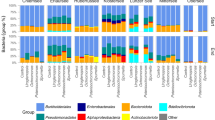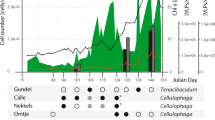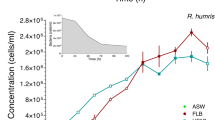Abstract
Aquatic assemblages of heterotrophic protists are very diverse and formed primarily by organisms that remain uncultured. Thus, a critical issue is assigning a functional role to this unknown biota. Here we measured grazing rates of uncultured protists in natural assemblages (detected by fluorescent in situ hybridization (FISH)), and investigated their prey preference over several bacterial tracers in short-term ingestion experiments. These included fluorescently labeled bacteria (FLB) and two strains of the Roseobacter lineage and the family Flavobacteriaceae, of various cell sizes, which were offered alive and detected by catalyzed reporter deposition-FISH after the ingestion. We obtained grazing rates of the globally distributed and uncultured marine stramenopiles groups 4 and 1 (MAST-4 and MAST-1C) flagellates. Using FLB, the grazing rate of MAST-4 was somewhat lower than whole community rates, consistent with its small size. MAST-4 preferred live bacteria, and clearance rates with these tracers were up to 2 nl per predator per h. On the other hand, grazing rates of MAST-1C differed strongly depending on the tracer prey used, and these differences could not be explained by cell viability. Highest rates were obtained using FLB whereas the flavobacteria strain was hardly ingested. Possible explanations would be that the small flavobacteria cells were outside the effective size range of edible prey, or that MAST-1C selects against this particular strain. Our original dual FISH protocol applied to grazing experiments reveals important functional differences between distinct uncultured protists and offers the possibility to disentangle the complexity of microbial food webs.
Similar content being viewed by others
Log in or create a free account to read this content
Gain free access to this article, as well as selected content from this journal and more on nature.com
or
References
Alonso-Sáez L, Balagué V, Sà EL, Sánchez O, González JM, Pinhassi J et al. (2007). Seasonality in bacterial diversity in north-west Mediterranean coastal waters: assessment through clone libraries, fingerprinting and FISH. FEMS Microbiol Ecol 60: 98–112.
Boenigk J, Arndt H, Cleven EJ . (2001). The problematic nature of fluorescently labeled bacteria (FLB) in Spumella feeding experiments—an explanation by using video microscopy. Arch Hydrobiol 152: 329–338.
Boenigk J, Jost S, Stoeck T, Garstecki T . (2007). Differential thermal adaptation of clonal strains of a protist morphospecies originating from different climatic zones. Environ Microbiol 9: 593–602.
Buchan A, González JM, Moran MA . (2005). Overview of the marine Roseobacter lineage. Appl Environ Microbiol 71: 5665–5677.
Eccleston-Parry JD, Leadbeater BSC . (1994). A comparison of the growth kinetics of six marine heterotrophic nanoflagellates fed with one bacterial species. Mar Ecol Prog Ser 105: 167–177.
Epstein S, López-García P . (2008). ‘Missing’ protists: a molecular prospective. Biodivers Conserv 17: 261–276.
Falcioni T, Papa S, Gasol JM . (2008). Evaluating the flow-cytometric nucleic acid double-staining protocol in realistic situations of planktonic bacterial death. Appl Environ Microbiol 74: 1767–1779.
Fenchel T . (1982). Ecology of heterotrophic microflagellates. II. Bioenergetics and growth. Mar Ecol Prog Ser 8: 225–231.
Fenchel T . (1987). Ecology of Protozoa: The Biology of Free-Living Phagotrophic Protists. Brock/Springer Series in Contemporary Bioscience, Springer: Berlin.
González JM, Sherr EB, Sherr BF . (1990). Size-selective grazing on bacteria by natural assemblages of estuarine flagellates and ciliates. Appl Environ Microbiol 56: 583–589.
González JM, Sherr EB, Sherr BF . (1993). Differential feeding by marine flagellates on growing versus starving, and on motile versus nonmotile, bacterial prey. Mar Ecol Prog Ser 102: 257–267.
Grégori G, Citterio S, Ghiani A, Labra M, Sgorbati S, Brown S et al. (2001). Resolution of viable and membrane-compromised bacteria in freshwater and marine waters based on analytical flow cytometry and nucleic acid double staining. Appl Environ Microbiol 67: 4662–4670.
Jezbera J, Hornak K, Simek K . (2005). Food selection by bacterivorous protists: insight from the analysis of the food vacuole content by means of fluorescence in situ hybridization. FEMS Microbiol Ecol 52: 351–363.
Jürgens K, Matz C . (2002). Predation as a shaping force for the phenotypic and genotypic composition of planktonic bacteria. Antonie van Leeuwenhoek 81: 413–434.
Jürgens K, Massana R . (2008). Protistan grazing on marine bacterioplankton. In: Kirchman DL (ed). Microbial Ecology of the Oceans, 2nd edn. Wiley: New York, pp 383–441.
Kirchman DL . (2002). The ecology of Cytophaga-Flavobacteria in aquatic environments. FEMS Microbiol Ecol 39: 91–100.
Landry MR, Lehner-Fournier JM, Sundstrom JA, Fagerness VL, Selph KE . (1991). Discrimination between living and heat-killed prey by a marine zooflagellate Paraphysomonas vestita (Stokes). J Exp Mar Biol Ecol 146: 139–152.
Lim EL, Dennet MR, Caron DA . (1999). The ecology of Paraphysomonas imperforata based on studies employing oligonucleotide probe identification in coastal water samples and enrichment cultures. Limnol Oceanogr 44: 37–51.
Massana R, Gasol JM, Bjørnsen PK, Blackburn N, Hagström Å, Hietanen S et al. (1997). Measurement of bacterial size via image analysis of epifluorescence preparations: description of an inexpensive system and solutions to some of the most common problems. Sci Mar 61: 397–407.
Massana R, Guillou L, Díez B, Pedrós-Alió C . (2002). Unveiling the organisms behind novel eukaryotic ribosomal DNA sequences from the ocean. Appl Environ Microbiol 68: 4554–4558.
Massana R, Terrado R, Forn I, Lovejoy C, Pedrós-Alió C . (2006a). Distribution and abundance of uncultured heterotrophic flagellates in the world oceans. Environ Microbiol 8: 1515–1522.
Massana R, Guillou L, Terrado R, Forn I, Pedrós-Alió C . (2006b). Growth of uncultured heterotrophic flagellates in unamended seawater incubations. Aquat Microb Ecol 45: 171–180.
Matz C, Jürgens K . (2001). Effects of hydrophobic and electrostatic cell surface properties of bacteria on feeding rates of heterotrophic nanoflagellates. Appl Environ Microbiol 67: 814–820.
Matz C, Jürgens K . (2005). High motility reduces grazing mortality of planktonic bacteria. Appl Environ Microbiol 71: 921–929.
Mohapatra BR, Fukami K . (2004). Comparison of the numerical grazing response of two marine heterotrophic nanoflagellates fed with different bacteria. J Sea Res 52: 99–107.
Moon-van der Staay SY, De Wachter R, Vaulot D . (2001). Oceanic 18S rDNA sequences from picoplankton reveal unsuspected eukaryotic diversity. Nature 409: 607–610.
Not F, Latasa M, Marie D, Cariou T, Vaulot D, Simon N . (2004). A single species, Micromonas pusilla (Prasinophyceae), dominates the eukaryotic picoplankton in the Western English Channel. Appl Environ Microbiol 70: 4064–4072.
Pernthaler A, Pernthaler J, Amann R . (2002). Fluorescence in situ hybridization and catalyzed reporter deposition for the identification of marine bacteria. Appl Env Microbiol 68: 3094–3101.
Pernthaler J, Glöckner FO, Schönhuber W, Amann R . (2001). Fluorescence in situ hybridization (FISH) with rRNA-targeted oligonucleotide probes. In: Paul JH (ed). Marine Microbiology. Academic Press: London, pp 207–226.
Pernthaler J . (2005). Predation on prokaryotes in the water column and its ecological implications. Nat Rev Microbiol 3: 537–546.
Porter KG, Feig YS . (1980). The use of DAPI for identifying and counting aquatic microflora. Limnol Oceanogr 25: 943–948.
Rodríguez F, Derelle E, Guillou L, Le Gall F, Vaulot D, Moreau H . (2005). Ecotype diversity in the marine picoeukaryote Ostreococcus (Chlorophyta, Prasinophyceae). Environ Microbiol 7: 853–859.
Sanders RW, Caron DA, Berninger UG . (1992). Relationships between bacteria and heterotrophic nanoplankton in marine and fresh waters: an inter-ecosystem comparison. Mar Ecol Prog Ser 86: 1–14.
Shannon SP, Chrzanowski TH, Grover JP . (2007). Prey food quality affects flagellate ingestion rates. Microb Ecol 53: 66–73.
Sherr BF, Sherr EB, Fallon RD . (1987). Use of monodispersed, fluorescently labeled bacteria to estimate in situ protozoan bacterivory. Appl Environ Microbiol 53: 958–965.
Sherr EB, Sherr BF . (2002). Significance of predation by protists in aquatic microbial food webs. Antonie van Leeuwenhoek 81: 293–308.
Sieracki ME, Haas LW, Caron DA, Lessard EJ . (1987). Effect of fixation on particle retention by microflagellates: underestimation of grazing rates. Mar Ecol Prog Ser 38: 251–258.
Simek K, Jezbera J, Hornák K, Vrba J, Sed′a J . (2004). Role of diatom-attached choanoflagellate of the genus Salpingoeca as pelagic bacterivores. Aquat Microb Ecol 36: 257–269.
Strom SL . (2000). Bacterivory: interactions between bacteria and their grazers. In: Kirchman DL (ed). Microbial Ecology of the Oceans. Wiley-Liss Inc: New York, pp 351–386.
Unrein F, Massana R, Alonso-Sáez L, Gasol JM . (2007). Significant year-round effect of small mixotrophic flagellates on bacterioplankton in an oligotrophic coastal system. Limnol Oceanogr 52: 456–469.
Urdea MS, Warner BD, Running JA, Stempien M, Clyne J, Horn T . (1988). A comparison of non-radioisotopic hybridization assay methods using fluorescent, chemiluminescent and enzyme labeled synthetic oligodeoxyribonucleotide probes. Nucleic Acids Res 16: 4937–4956.
Vaqué D, Gasol JM, Marrasé C . (1994). Grazing rates on bacteria: the significance of methodology and ecological factors. Mar Ecol Prog Ser 109: 263–274.
Vaulot D, Romari K, Not F . (2002). Are autotrophs less diverse than heterotrophs in marine picoplankton? Trends Microbiol 10: 266–267.
Acknowledgements
This study was supported by the project ESTRAMAR (CTM2004-12631/MAR, MEC) to RM. FN was supported by the Marie-Curie fellowship ESUMAST (MEIF-CT-2005-025000) and TL by the project METAOCEANS (MEST-CT-2005-019678). We thank Josep M Gasol for help in flow cytometry, Matthias Engel for microscopic counts and Marta Ribes for statistical advice.
Author information
Authors and Affiliations
Corresponding author
Rights and permissions
About this article
Cite this article
Massana, R., Unrein, F., Rodríguez-Martínez, R. et al. Grazing rates and functional diversity of uncultured heterotrophic flagellates. ISME J 3, 588–596 (2009). https://doi.org/10.1038/ismej.2008.130
Received:
Revised:
Accepted:
Published:
Issue date:
DOI: https://doi.org/10.1038/ismej.2008.130
Keywords
This article is cited by
-
Top-down structuring of freshwater bacterial communities by mixotrophic flagellates
ISME Communications (2023)
-
Trophic flexibility of marine diplonemids - switching from osmotrophy to bacterivory
The ISME Journal (2022)
-
Availability of vitamin B12 and its lower ligand intermediate α-ribazole impact prokaryotic and protist communities in oceanic systems
The ISME Journal (2022)
-
How Communities of Marine Stramenopiles Varied with Environmental and Biological Variables in the Subtropical Northwestern Pacific Ocean
Microbial Ecology (2022)
-
Comparative genomics reveals new functional insights in uncultured MAST species
The ISME Journal (2021)



